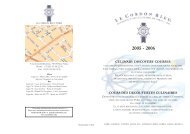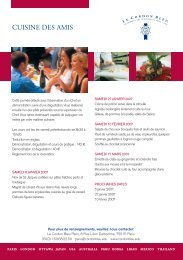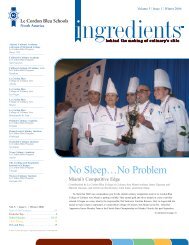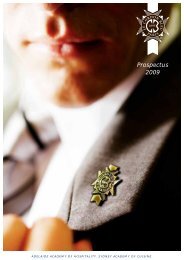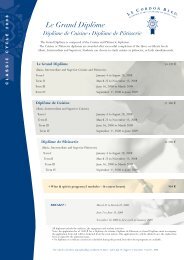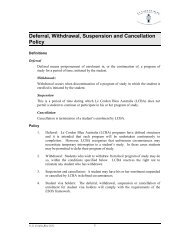OCA “WACS” Global Challenge - Le Cordon Bleu
OCA “WACS” Global Challenge - Le Cordon Bleu
OCA “WACS” Global Challenge - Le Cordon Bleu
Create successful ePaper yourself
Turn your PDF publications into a flip-book with our unique Google optimized e-Paper software.
Volume 8 | Issue 3 | Winter 2007<br />
Atlantic Culinary Academy,<br />
a Division of McIntosh College<br />
<strong>Le</strong> <strong>Cordon</strong> <strong>Bleu</strong> Program<br />
Dover, NH<br />
_____________________________<br />
California Culinary Academy<br />
<strong>Le</strong> <strong>Cordon</strong> <strong>Bleu</strong> Program<br />
San Francisco<br />
_____________________________<br />
California School of Culinary Arts<br />
<strong>Le</strong> <strong>Cordon</strong> <strong>Bleu</strong> Program<br />
Pasadena<br />
_____________________________<br />
<strong>Le</strong> <strong>Cordon</strong> <strong>Bleu</strong><br />
College of Culinary Arts<br />
Atlanta<br />
_____________________________<br />
<strong>Le</strong> <strong>Cordon</strong> <strong>Bleu</strong><br />
College of Culinary Arts<br />
Las Vegas<br />
_____________________________<br />
<strong>Le</strong> <strong>Cordon</strong> <strong>Bleu</strong><br />
College of Culinary Arts<br />
Miami<br />
_____________________________<br />
<strong>Le</strong> <strong>Cordon</strong> <strong>Bleu</strong><br />
College of Culinary Arts<br />
Minneapolis/St. Paul<br />
_____________________________<br />
<strong>Le</strong> <strong>Cordon</strong> <strong>Bleu</strong><br />
Institute of Culinary Arts<br />
Dallas<br />
_____________________________<br />
Orlando Culinary Academy<br />
<strong>Le</strong> <strong>Cordon</strong> <strong>Bleu</strong> Program<br />
Orlando<br />
_____________________________<br />
Pennsylvania Culinary Institute<br />
<strong>Le</strong> <strong>Cordon</strong> <strong>Bleu</strong> Program<br />
Pittsburgh<br />
_____________________________<br />
Scottsdale Culinary Institute<br />
<strong>Le</strong> <strong>Cordon</strong> <strong>Bleu</strong> Program<br />
Scottsdale<br />
_____________________________<br />
Texas Culinary Academy<br />
<strong>Le</strong> <strong>Cordon</strong> <strong>Bleu</strong> Program<br />
Austin<br />
_____________________________<br />
The Cooking and Hospitality<br />
Institute of Chicago<br />
<strong>Le</strong> <strong>Cordon</strong> <strong>Bleu</strong> Program<br />
Chicago<br />
_____________________________<br />
Western Culinary Institute<br />
<strong>Le</strong> <strong>Cordon</strong> <strong>Bleu</strong> Program<br />
Portland, OR<br />
Vol. 8 | Issue 3 | Winter 2007<br />
Education. . . . . . . . . . . . . . . . . . . . . . . 1-4<br />
From the Top . . . . . . . . . . . . . . . . . . . . . 2<br />
School Scoops . . . . . . . . . . . . . . . . . . 5-11<br />
Chefs Rising . . . . . . . . . . . . . . . . . . 12-14<br />
Pots and Pans . . . . . . . . . . . . . . . . . . . . 15<br />
® The <strong>Le</strong> <strong>Cordon</strong> <strong>Bleu</strong> logo is a registered trademark<br />
of <strong>Le</strong> <strong>Cordon</strong> <strong>Bleu</strong> BV.<br />
LCB-17508 12/2007<br />
<strong>OCA</strong> <strong>“WACS”</strong><br />
<strong>Global</strong> <strong>Challenge</strong><br />
<strong>OCA</strong> Hosts WACS <strong>Global</strong> Chefs <strong>Challenge</strong><br />
By Chef David Weir, CEC, CCE<br />
Director of Compliance – Orlando Culinary Academy<br />
Orlando Culinary Academy was honored to host the 2007 World Association of<br />
Chefs Societies (WACS) <strong>Global</strong> Chefs <strong>Challenge</strong> Continental on July 21, to determine<br />
the Americas representative at the 2008 WACS <strong>Global</strong> Chefs Competition for the title<br />
of WACS <strong>Global</strong> Chef. The international competition typically coincides with the<br />
WACS biannual World Congress and sets the stage for a top–level worldwide competition<br />
that results in the selection of a World Association of Chef Societies <strong>Global</strong> Chef, every<br />
other year.<br />
First place winner, Chef Aidan P. Murphy, CMC, AAC, Old Warson Country Club<br />
Executive Chef, St. Louis, will compete in the final WACS <strong>Global</strong> Chefs Competition<br />
at the WACS World Congress, May 12–15, 2008, in Dubai, for the title of WACS<br />
<strong>Global</strong> Chef.<br />
(continued on page 3)
From the Top<br />
Opening Lines of Culinary Communication<br />
“Everyone can be great,<br />
because everyone can serve.”<br />
— Martin Luther King, Jr.<br />
Austin Children's Shelter Volunteers included Texas Culinary Academy Students:<br />
Stephen Poppell, Dennie-Rae Monreal, Jessica Burkhart, Mary McCaskey, and Juan Baca<br />
“Service is more than just an<br />
action or an event; it is a<br />
mindset that permeates all that<br />
we do at <strong>Le</strong> <strong>Cordon</strong> <strong>Bleu</strong><br />
Schools North America.”<br />
Students of Service<br />
By Dominick Fedele, VP Managing Director – <strong>Le</strong> <strong>Cordon</strong> <strong>Bleu</strong> Schools North America<br />
The idea of service is uniquely compelling to me-as it relates<br />
directly to what we teach at our schools as well as to a larger philosophy<br />
that we embrace at <strong>Le</strong> <strong>Cordon</strong> <strong>Bleu</strong> Schools North America. Indeed,<br />
community service forms the core of what it means to be a culinary<br />
professional.<br />
Service as a Mindset<br />
Service is more than just an action or an event; it is a mindset that<br />
permeates all that we do at <strong>Le</strong> <strong>Cordon</strong> <strong>Bleu</strong> Schools North America.<br />
Maybe it's easier to make this a part of our schools' culture, since many<br />
of our employees came from service-oriented backgrounds where the<br />
needs of customers came first. But that's not enough. We have systems<br />
that help support a culture of service so that each and every employee,<br />
student, and industry partner gets what they need, when they need it.<br />
A service-oriented mindset sets the stage for success at our schools<br />
as it signals a connection to the community and demonstrates that our<br />
work impacts everyone around us. Charged with educating our students<br />
and preparing them for success in the industry, our faculty members are<br />
students of service who have committed themselves to passing along<br />
the importance of this concept to the next generation of professionals.<br />
Commitment to Service<br />
A commitment to service paves the way to excellence. In giving a bit<br />
of yourself, you help those around you grow and prosper. The benefit<br />
of service is not in the idea, but in the action – and I trust that all of you<br />
will embrace this idea and act upon it.<br />
Service in the Community<br />
I am often reminded of how our schools have embedded themselves<br />
in their larger community. Many schools have adopted specific programs<br />
that help support a particular cause or mission. For example, Texas<br />
Culinary Academy has supported the Austin Children's Shelter for the<br />
last four years. Chef Aimee Olson and Chef Cara Anam have committed<br />
themselves to this mission of this organization – and students have<br />
followed suit and helped prepare holiday meals. By taking part in the<br />
service learning exercise, these students are afforded an opportunity to<br />
apply what they've learned in the classroom to a real-world setting.<br />
This sort of service sets a positive example that serves as an inspiration<br />
to the children at the center. It helps them realize that, through service,<br />
everyone has something to give. ■<br />
2
the Americas in the Dubai competition. Second and third place was<br />
awarded to Chef Brad Horen representing Canada, and Chef Tracey<br />
Sweeting representing the Bahamas, respectively.<br />
After the event, the chefs and students of the Orlando Culinary<br />
Academy hosted a gala reception to honor the competitors and invited<br />
dignitaries from around the world. The guest of honor was Chef<br />
Ferdinand Metz, CMC, AAC, HOF, WACS World President. Chef Metz<br />
was recognized as an Ambassador of Culinary Arts for <strong>Le</strong> <strong>Cordon</strong> <strong>Bleu</strong> by<br />
Chef Kirk Bachmann, VP of Academic Affairs for <strong>Le</strong> <strong>Cordon</strong> <strong>Bleu</strong><br />
North America, and Chef Patrick Martin, International Corporate<br />
Executive Chef for <strong>Le</strong> <strong>Cordon</strong> <strong>Bleu</strong> International.<br />
Invited guests were treated to an array of food prepared by five<br />
<strong>OCA</strong> chefs: Richard Rosado, Jimmy Wessman, Tracy Fisher, Tony<br />
Adams, and Alexis Rodriguez. Two of the academy's Pâtisserie and<br />
Baking students prepared an incredible spread of Petit Fours and<br />
desserts. Each chef, with assistance from selected students, prepared<br />
one action station and a selection of hot and cold hors d'oeuvres. ■<br />
<strong>OCA</strong> Hosts WACS<br />
(continued from front page)<br />
Designed to focus international attention on both the global culinary<br />
profession and the World Association of Chefs Societies, the challenge<br />
is unlike other team competitions as it is specifically designed for a<br />
major single chef competition. Additionally, WACS strives to create a<br />
cuisine-orientated focal point for continental forums along with each<br />
World Congress and opportunities for chefs from every WACS member<br />
country to compete on a global basis.<br />
This event determined the representative from the Americas<br />
(North America, Central America, and South America) to compete in<br />
the <strong>Global</strong> Competition which will be held in Dubai in May 2008.<br />
The inaugural competition included individual chefs and their apprentice<br />
representing eight countries including: Canada, The United States,<br />
Brazil, Chile, Guatemala, The Bahamas, Uruguay, and Bolivia. The<br />
competitors were required to prepare and present a well balanced<br />
four-course menu (starter, entrée, main course, dessert) for eight. The<br />
menu was created from a market basket which was presented to the<br />
competitors the day prior to the competition, as well as the “common<br />
pantry” of ingredients. The total time allotted for the competition was<br />
6 hours and 45 minutes.<br />
The event chairman was Chef Reimund Pitz, CEC, CCE, AAC,<br />
Executive Chef at the Country Club of Orlando. Chef Pitz is a former<br />
American Culinary Federation (ACF) National President, and has been<br />
very active in WACS over the past several years. The Co-Chair for the<br />
event was Chef Jason Klingensmith, CSC, Chef de Cuisine at the<br />
Country Club of Orlando. The event was coordinated at the school by<br />
Chefs Michael Lodge CEC, CFBE and David Weir CEC, CCE. Many<br />
of the faculty and students of the academy also participated in the event<br />
to ensure that it was successful.<br />
First place winner Chef Aidan P. Murphy, CMC, AAC, was previously<br />
recognized as the 2006 ACF Chef of the Year, the highest honor<br />
bestowed on an industry chef by the ACF. Chef Murphy will represent<br />
Extraordinary Members<br />
3
Using Assessment as a<br />
<strong>Le</strong>arning Tool for<br />
“Generation Y” <strong>Le</strong>arners<br />
By Chef Kirk T. Bachmann, M.Ed., CEC, CCP,<br />
Vice President of Education – <strong>Le</strong> <strong>Cordon</strong> <strong>Bleu</strong> Schools North America<br />
“... as it turns out career-focused<br />
culinary arts and hospitality<br />
education is uniquely suited for<br />
this generation (Gen Y)<br />
of students.”<br />
Our student population is truly diverse—with learners from all age<br />
groups, backgrounds, and educational levels. But one group, those from<br />
the so-called Generation Y, is of particular interest to me when it comes<br />
to assessment practices.<br />
Generation Y (or Gen Y) refers to the 80 million or so young<br />
Americans who were born between 1978 and 1995. This population<br />
represents the future of our industry, so it is vital that we understand<br />
their educational needs. And, as it turns out, career-focused culinary<br />
arts and hospitality education is uniquely suited for this generation of<br />
students. Why?<br />
Gen Y learners tend to perform best in fast environments where<br />
they are required to multitask and work collaboratively; and while they<br />
prefer to work in teams, they also demand individual feedback and<br />
focused attention. These learners prefer hands-on work over lectures<br />
and expect technology to play a part in the educational process.<br />
Furthermore, Gen Y learners need to know that what they learn in the<br />
classroom can directly benefit them on the job.<br />
For these reasons, Gen Y students can greatly benefit from assessment<br />
methods that deal directly with performance and the achievement of<br />
specific learning outcomes.<br />
When selecting a methodology, there are several core questions<br />
which should be addressed:<br />
• What technique, skill, idea or concept is being assessed?<br />
• Why does this need to be assessed? What value does it bring?<br />
• How does the assessment process support students in their<br />
larger educational goals?<br />
• Does the assessment process actively engage and encourage<br />
students to succeed?<br />
The expectations and values of Gen Y learners are truly different<br />
from other previous generations – and it's important to realize this and<br />
embrace the differences. In doing so, we show them that we care about<br />
their own personal and professional success. ■<br />
4
School Scoops<br />
School Happenings<br />
LCB Atlanta<br />
Give Me Five!<br />
By Lori Flynn, Externship <strong>Le</strong>ad Chef Instructor<br />
– <strong>Le</strong> <strong>Cordon</strong> <strong>Bleu</strong> College of Culinary Arts Atlanta<br />
Give Me Five, a five-course sit-down dinner prepared by Georgia's<br />
finest chefs was an exemplary culinary experience for students and<br />
guests. Each course featured a wine pairing and commentary by five of<br />
the state's most respected sommeliers. To add to the excitement, nine<br />
students from <strong>Le</strong> <strong>Cordon</strong> <strong>Bleu</strong> College of Culinary Arts Atlanta were<br />
on hand to help the chefs produce an incredible meal to fight hunger –<br />
another Share Our Strength ® success!<br />
The shining star students were: David Aman, June Grant, Whitney<br />
Otawka, Jahaan Parker, Veronica Ripp, Zachery Rogers, Casey Scott,<br />
Inonda Williams and Emily Williams. In order to qualify, students had<br />
to pass a bench test: a 3.75 or higher G.P.A; 90% or higher overall<br />
attendance; and three Chef Instructor recommendations.<br />
The students performed famously and relished the opportunity of<br />
working side-by-side in the kitchen with the accomplished chefs.<br />
The chefs stated they would take this team of students to any event,<br />
anywhere or any time. Their hard work and dedication showed in<br />
everything they did! ■<br />
The Cooking and Hospitality<br />
Institute of Chicago<br />
Meals on Wheels Chicago<br />
Celebrity Chef Gala<br />
By Chef John Montanile, CCE, CEPC, CMA<br />
Department Chair, Pâtisserie & Baking<br />
– The Cooking & Hospitality Institute of Chicago<br />
Macy's on State Street provided the glamorous setting for this<br />
year's Chicago Celebrity Chef Gala – an event that draws in both local<br />
and nationally known chefs to raise awareness for Meals on Wheels<br />
Chicago, an organization that promotes independence for the elderly<br />
and the disabled. The Cooking and Hospitality Institute of Chicago<br />
provided a lavish display of assorted chocolate truffles, pâtes de fruit<br />
and nougat montelimar.<br />
The event was divided into three parts: an early VIP reception, a<br />
seated dinner, and the Grand Ball. For $350 per person, guests savored<br />
foods from Chicago's finest restaurants including <strong>Le</strong> Titi de Paris,<br />
Frontera Grill, Blackbird, <strong>Le</strong> Bernadin, Dahlia Lounge and many more.<br />
CHIC pastry chef instructors made 150 pieces of each type of truffle<br />
or candy. Chef Amy Wolf, CEPC, CCE and Chef Toni <strong>Le</strong>ahy attended<br />
to the event; while <strong>Le</strong> <strong>Cordon</strong> <strong>Bleu</strong> Pâtisserie and Baking Program<br />
students, Michelle Pfeiffer and John Snyder, gave freely of their time<br />
and efforts. Special thanks go to the CHIC pastry team for helping to<br />
make this event a huge success. ■<br />
“For many, emergency meals make<br />
a significant difference assisting<br />
individuals in regaining their<br />
independence. For others, emergency<br />
meals are all that stand between<br />
independent living and a nursing home.”<br />
— Meals on Wheels<br />
5
<strong>Le</strong> <strong>Cordon</strong> <strong>Bleu</strong> College<br />
of Culinary Arts Miami<br />
Graduate Profile: Corey Anderson<br />
By Staff – <strong>Le</strong> <strong>Cordon</strong> <strong>Bleu</strong> College of Culinary Arts Miami<br />
Corey Anderson was born in Norfolk, Virginia and moved to North<br />
Miami Beach at the age of six. While attending Flannigan High School,<br />
he began working at a local pizza restaurant answering the phone and<br />
within six months was promoted to shift manager. After eighteen<br />
months, Anderson was promoted again; this time to assistant store<br />
manager. It was then, that he realized a burning desire to learn more<br />
about the culinary arts.<br />
Before too long, the future culinary student left the pizza restaurant<br />
for a more upscale establishment, called the Roasted Pepper, in<br />
Pembroke Pines, Florida. With the a vision of becoming a chef,<br />
Anderson researched South Florida culinary programs, before making<br />
his final decision to enroll in <strong>Le</strong> <strong>Cordon</strong> <strong>Bleu</strong> College of Culinary Arts<br />
Miami. <strong>Le</strong> <strong>Cordon</strong> <strong>Bleu</strong> offered a short-term program with hands-on<br />
learning which fit well with his busy schedule, and he really enjoyed the<br />
industry current kitchens. Anderson was also impressed by the quality<br />
of chef instructors and staff at the school – Chefs James Fraser and<br />
Dustin Gordon were to become his favorite culinary school mentors.<br />
Meanwhile, Roasted Pepper owner Frank Dias noticed Anderson's<br />
enthusiasm and desire to learn. His new mentor arranged for an<br />
externship with Chef Rocco Sacramone, a native Italian chef and the<br />
owner/operator of Trattoria L'incontro, in Astoria, New York. At this<br />
fine dining Italian restaurant, everything is made in-house from pastas<br />
to breads, pizza dough, sauces and desserts. Butchering and filleting is<br />
done in-house as well and fresh fish world is flown in daily from<br />
around the world.<br />
Once the externship was complete, Anderson worked an additional<br />
two months at the restaurant under the tutelage of Chef Sacramone.<br />
After the chef suggested that he bone-up on butchering and meat cuts,<br />
Anderson took a job with a local butcher. Chef Sacramone was very<br />
impressed with Anderson's thirst for knowledge and had a job waiting<br />
for him upon his return and, shortly thereafter, promoted him to the<br />
position of executive chef.<br />
As executive Chef,<br />
Anderson plans to expand the<br />
Roasted Pepper to a second<br />
location in the near future.<br />
The Roasted Pepper will host<br />
its first five course Wine<br />
Dinner with Executive Chef<br />
Corey Anderson at the helm,<br />
flanked by two of his cooks,<br />
both recent <strong>Le</strong> <strong>Cordon</strong> <strong>Bleu</strong><br />
College of Culinary Arts<br />
Miami graduates. ■<br />
<strong>Le</strong> <strong>Cordon</strong> <strong>Bleu</strong> College of<br />
Culinary Arts Minneapolis/St. Paul<br />
Profile of Student Success: Anne Loger<br />
By Farley Hernandez, Culinary Department Chair,<br />
– <strong>Le</strong> <strong>Cordon</strong> <strong>Bleu</strong> College of Culinary Arts<br />
Minneapolis/St. Paul<br />
Most instructors would agree there are times that we just stand<br />
back, watch our students, and wonder about their thought processes.<br />
We do this because we want to see how our students go about<br />
solving problems and to see who takes initiative. And while all students<br />
are in school to learn, it is still exhilarating to have a student in class who<br />
has the critical thinking skills and the common sense to make logical<br />
decisions but is still humble enough to take guidance and direction.<br />
I happened upon a student who demonstrated these attributes as<br />
she entered my class in the beginning of her program. Anne Loger<br />
immediately became someone who I could turn to to make sure the job<br />
got done efficiently and to the best of her ability.<br />
While attending the <strong>Le</strong> <strong>Cordon</strong> <strong>Bleu</strong> Culinary Arts Program, Loger<br />
was named the Captain of the ACF Junior Hot Foods competition team.<br />
She said that it was one of the most rewarding things she has ever<br />
done; in fact, pushing her team toward perfection was part of the daily<br />
challenge – a challenge that she met full-on and with pride.<br />
Loger says that the hardest part of school was making sure that she<br />
didn't fall into the procrastination trap. She points out that the biggest<br />
learning she has taken away is that every chef has a different perspective<br />
on food and kitchen management.<br />
After graduating with the highest grade in her class and completing<br />
an externship at Mackinac Island, Miss Loger was asked to help<br />
guide this year's ACF competition team. The staff noticed her strong<br />
determination from the beginning.<br />
Recently she was recruited as Assistant Chef in the Intro classes,<br />
where she assists students through basic skills and preps demonstrations<br />
for the chef instructor.<br />
Loger says that the best part of her new position is being able to<br />
identify with the students and their challenges. She says “If there was<br />
one thing that I could instill<br />
in every student, it would<br />
be to never stop learning”.<br />
Loger has found that<br />
cooking is very much an art<br />
and everyone has their<br />
own style. ■<br />
6
Western Culinary Institute<br />
Organic Taste<br />
By Julie Oken, Manager of Admissions Services<br />
– Western Culinary Institute<br />
On March 8, 2007 Western Culinary Institute and Chef Stu Stein<br />
were the proud hosts of a media luncheon introducing Henry Weinhard's<br />
Organic Premium Amber Ale to the already well-rounded Pacific<br />
Northwest brew scene. Chef Stein took great care to create menu that<br />
incorporated local sustainable products, and of course, beer in every<br />
recipe. The joining of these local products and WCI affirmed the ongoing<br />
collaboration between the school and the forward-thinking Portland<br />
food community.<br />
After an introduction showcasing how WCI students and staff are<br />
involved in local sustainable projects such as the Farm to Table Club,<br />
Chef Stein started the demonstration with a brief presentation about the<br />
certified organic label, sustainable cuisine, and the importance of the<br />
sustainable food system.<br />
Ecological, economical, and social/political factors were highlighted<br />
in the presentation. As a faculty member, Chef Stein hopes to introduce<br />
more people to these concepts. And while he sees value in the business<br />
side of the slow food movement, he is passionately committed to<br />
demonstrating that the best reason to use local organic ingredients is<br />
taste! This summer Chef Stein opened a new restaurant and wine bar,<br />
Terrior, which features seasonal – sustainable Pacific Northwest small<br />
plate restaurant. The restaurant is a logical next step for Chef Stein and<br />
the cutting edge culinarians who call the Pacific Northwest home.<br />
Chef Stu Stein's Menu:<br />
• Oxtail in Ale Broth with Spinach Ravioli<br />
• Ale–Braised Smoked Pork Spare Ribs<br />
• An assortment of Oregon Artisan Cheeses<br />
• Whole Wheat Beer Bread<br />
• Ale–Pear Yeasted Fritters with Malted Coffee Crunch<br />
Ice Cream and Caramel Sauce<br />
Brewed from 100% natural ingredients, the featured beer is<br />
organically certified and a local product using Pacific Northwest hops –<br />
Mt. Hood and Simcoe – which result in a hoppy, balanced brew without<br />
the grainy finish found in many organic beers. ■<br />
7
Scottsdale Culinary Institute<br />
Student Spotlight: Rebecca Chazan<br />
The “I Can” Mindset of<br />
Little Ms. Powerhouse<br />
By Staff – Scottsdale Culinary Institute<br />
For most people, the thought of having six children is daunting, if not<br />
frightening. Add to that a full-time job, a full course load at Scottsdale<br />
Culinary Institute (SCI) and an externship at one of the best restaurants in<br />
the Phoenix area, and you've got a recipe for a stress-induced meltdown –<br />
unless your name is Rebecca Chazan.<br />
For this student dealing with a hectic schedule is a small price to pay<br />
for pursuing her dream of a career in culinary arts. “I am passionate about<br />
food and love every minute of it,” Chazan said.<br />
Chazan's dream began nearly 15 years ago after she took an interest<br />
in cake decorating. First she attended several community classes, and<br />
then she began making wedding cakes for her friends and as donations<br />
for various fundraisers. While she didn't hold a culinary certification,<br />
Chazan quickly became the self-proclaimed “Martha Stewart” of her<br />
neighborhood, hosting frequent barbeques and parties at her home.<br />
After a move to California and three babies, Chazan decided to<br />
make her designation as “cook extraordinaire” official, and in October<br />
2006, she enrolled at Scottsdale Culinary Institute.<br />
“I suppose after watching the Food Network for so long, I wanted<br />
to 'kick it up a notch,'” Chazan said. “I have to laugh. If I ever met<br />
Emeril, I would tell him how my youngest three girls have snuggled up<br />
with me every night to fall asleep watching his show.”<br />
This fall, Chazan began an externship at Binkley's, a popular<br />
Phoenix restaurant that is owned and operated by award-winning SCI<br />
alum, Chef Kevin Binkley. The restaurant specializes in classically<br />
influenced American cuisine. “Chef Binkley and his staff are incredibly<br />
talented. Between my externship and SCI, I will learn a lot.”<br />
When Chazan isn't whipping up tantalizing dishes at Binkley's, she's<br />
keeping busy as the fundraising chair for her children's school, raising<br />
$40,000 to $50,000 a year. She's also an avid runner with 10 marathons<br />
under her belt.<br />
Chazan will complete her associate's degree program at SCI after her<br />
externship at Binkley's ends in December. “I haven't decided what to do,”<br />
Chazan said. “I am not the type of person who sees limitation, so I figure<br />
that the world is wide open.” ■<br />
Orlando Culinary Academy<br />
Choices<br />
By Greg Forte CEC, CCE, AAC, MS<br />
Director of Education – Orlando Culinary Academy<br />
Opportunities for today's culinary school graduate are not the same as<br />
30 years ago. In 2007, you can also pursue a career as a food stylist,<br />
recipe developer, personal chef, food demonstrator, food journalist or in<br />
foodservice equipment sales.<br />
As a chef educator, I once believed that all of our graduates should<br />
pay their dues on the line and move up through the ranks in the back of<br />
the house of a fine hotel or restaurant as I once did. Then, a former<br />
student called to say “hello” and it changed everything.<br />
When I asked him what he was doing for a career, he was silent; and I<br />
was curious. After explaining that he was managing a group of five quick<br />
service restaurants; working only 40 to 45 hours per week, earning an<br />
outstanding salary, had a company car, and still had time to enjoy his new<br />
family, he sounded almost apologetic. He was not, after all, creating fine<br />
sauces or executing classical preparations, but he was content and happy<br />
with his career choice.<br />
It struck me that this former student had chosen to use a different skill<br />
set – one that leveraged his management training instead of technical<br />
training. In school, he learned how to lead and supervise employees,<br />
understand the process of controlling costs, and manage the operations at<br />
a number of restaurants.<br />
This conversation started a slow metamorphosis of what ought a culinary<br />
graduate might do with a degree and how each graduate could measure<br />
his or her success. My conclusion – the world of food seems to<br />
expand everyday and there are indeed many employment outcomes that<br />
can be expected from formal culinary training. ■<br />
8
<strong>Le</strong> <strong>Cordon</strong> <strong>Bleu</strong> College of<br />
Culinary Arts Las Vegas<br />
Why Math?<br />
By Gary Brant, Chef Instructor<br />
– <strong>Le</strong> <strong>Cordon</strong> <strong>Bleu</strong> College of Culinary Arts Las Vegas<br />
I recently had a very enlightening conversation with one of our<br />
students here. We were discussing the merits, values and necessity of<br />
some lecture classes on the program. The conversation went something<br />
like this:<br />
Student: Chef, why do I need to take a math class? I'm here to cook.<br />
Chef Gary: Do you want to be a cook? Or a chef?<br />
Student: Well, a chef, of course.<br />
Chef Gary: Okay, so now you're a chef at a modest little restaurant that<br />
serves maybe 120 covers a night on average. Are you there by yourself<br />
or do you have a staff working for you?<br />
Student: I need a staff, of course.<br />
Chef Gary: Like what?<br />
Student: Like a prep person, a line cook or two, a broiler cook and<br />
like that.<br />
Chef Gary: You know how to cook. Does your broiler cook know how<br />
to cook?<br />
Student: He'd better, or I'll get someone who can!<br />
Chef Gary: If you both know how to cook, what makes you different<br />
from him?<br />
Student: I'm the boss in the kitchen!<br />
Chef Gary: Right! And, as the boss, you are the leader of the team, the<br />
person who manages the kitchen so it makes money?<br />
Student: Yeah…<br />
Chef Gary: Who does the food costs? Who does the labor costing?<br />
Who picks the purveyor to supply you with the things you need? Who<br />
does the yield tests and compares AP & EP costs?<br />
Student: I do?<br />
Chef Gary: Who decides on vacation times if there is a dispute? Who<br />
interviews the new staff members and does the hiring? Who actually<br />
builds your kitchen into a smooth, efficient team?<br />
Student: Me?<br />
Chef Gary: When this restaurant hired you as their chef, they didn't<br />
hire you just because you could cook, did they? They hired you because<br />
you could run their kitchen and make them money, while satisfying the<br />
needs and wants of their customers.<br />
While the cooking is an important part of being a Chef, there are<br />
many other parts as well. A lot of people out there can cook, but not<br />
everyone who can cook has the special training it takes to truly be a<br />
chef.<br />
Student: I'm beginning to see…<br />
Chef Gary: Those “boring” lecture courses like Math and Kitchen<br />
Management help to round you out as a person. They are needed to<br />
give you the training you need to be a successful manager and leader,<br />
not just a cook.<br />
Your cooking classes are very important and will get you into that<br />
chef position someday, but developing an effective and efficient staff,<br />
controlling costs, and actually being a leader in the industry will help<br />
you get those big “bonuses” and recognition as a quality chef and<br />
someone people want to work for.<br />
Student: Wow…I never really thought of it that way, but that does<br />
make sense. Thank you, Chef.<br />
Chef Gary: You're welcome…now get to class! ■<br />
Student: Yes…<br />
Chef Gary: As chef you develop new items for the menu?<br />
9
Texas Culinary Academy<br />
Asia Food Fest<br />
By Sam Armstrong, Marketing Coordinator,<br />
– Texas Culinary Academy<br />
“Our <strong>Le</strong> <strong>Cordon</strong> <strong>Bleu</strong> programs are built on French customs, however<br />
our students graduate with skills that are invaluable to any culinary<br />
tradition,” said TCA Executive Chef William McKenna about the threeday<br />
2007 Asia Food Fest, co-sponsored by Texas Culinary Academy<br />
(TCA) and the Texas Asian Chamber of Commerce. “We were proud to<br />
be a part of an event that celebrates the incredibly rich and diverse<br />
worlds of Asian cuisine,” he added.<br />
The September event featured an Asian marketplace where local<br />
vendors educated visitors on Asian ingredients including the exotic<br />
tamarind. Guests also watched amateur and professional culinary teams<br />
go head-to-head in an “Iron Chef Contest” at Texas Culinary Academy.<br />
The contestants were judged by local food experts, media representatives<br />
and Central Texas celebrity chefs.<br />
“It was a great chance for our students and community partners to<br />
embrace innovative culinary points of view while engaging in healthy<br />
competition,” said McKenna.<br />
Several cooking classes hallmarked TCA's contribution, including<br />
Asian Cooking in the Eye of an American Chef, Asian Food History<br />
At-A-Glance, Cambodian Cuisines, Dim Sum by the Pro, Fruit &<br />
Vegetable Carving, Indian Cuisine, Japanese Cuisine, and What Makes<br />
Thai Food Hot?<br />
TCA and Austin - area chefs also presented a five-course “Asian<br />
Banquet with a French Twist” in TCA's Ventana Restaurant. Asian<br />
traditions and techniques from <strong>Le</strong> <strong>Cordon</strong> <strong>Bleu</strong> joined forces with<br />
masterful wine pairings to provide a unique experience for every guest's<br />
palate. ■<br />
California School of Culinary Arts<br />
LA Story – Bass Guitarist Turns Chef<br />
By Craig Riker – Student,<br />
– California School of Culinary Arts, Pasadena<br />
What was it like being in a rock band?<br />
It was great when we were playing shows, doing photo shoots,<br />
going to cool parties, meeting amazing friends and seeing the world.<br />
The business side can take friends who are doing what they love and<br />
turn them against each other in the quest for fame and fortune. The<br />
life/fun can quickly get sucked out of you because you are worried<br />
about the bottom line and not the art you create.<br />
How does the new career compare to the old one?<br />
There are similarities – long hours, commitment to excellence. You<br />
get to be creative and work with your hands. A kitchen has to be a<br />
well–oiled machine to be successful, just like a band. Both jobs can be<br />
equally intense.<br />
I suggest people consider taking risks. Don't get stuck doing something<br />
you are not happy doing. Money is not everything. It's not worth<br />
your peace of mind. If you have always wanted to do something else,<br />
go for it! Give it a try – you might like it! Do something you love and<br />
have a passion for – it will change your life. You are here for a purpose.<br />
You can make a difference.<br />
With cooking, I can make people happy. I feel like I have a purpose<br />
now. I think education is extremely important in any job. The learning<br />
doesn't end with school; it is an ongoing process. You have to strive to<br />
be a better person and constantly work on evolving new ideas to keep<br />
things fresh. ■<br />
10
<strong>Le</strong> <strong>Cordon</strong> <strong>Bleu</strong> Institute of<br />
Culinary Arts Dallas<br />
Mighty Morels<br />
By Bruce Konowalow, Director of Education<br />
– <strong>Le</strong> <strong>Cordon</strong> <strong>Bleu</strong> Institute of Culinary Arts Dallas<br />
Morels are heavenly words for those of us that salivate knowing<br />
that the long-awaited harvest is soon to begin. This edible fungi prized<br />
by mycologists, mushroom hunters, and foodies is one of the primary<br />
pleasures of early spring as their earthy flavor makes them the tastiest<br />
of all mushrooms.<br />
Every spring, across the upper Midwest, mushroom hunters traipse<br />
off to their secret spots in the woods searching for this elusive and costly<br />
culinary delight. There is no consistent place or type of environment<br />
that guarantees there will be morels growing. They seem to prefer<br />
undisturbed forest floors and areas that house large oak, elm and ash<br />
trees. Apple orchards, black cherry trees and areas that have been subject<br />
to a forest fire can create the preferred environment if the rainfall and<br />
the temperature are just right. Because of this uncertainty, it is especially<br />
difficult to cultivate these mushrooms commercially.<br />
The prized black morel is usually found in the last two weeks of<br />
April and the first two weeks in May. In the Midwest there is believed<br />
to be three varieties of morel, the yellow, the black and the half-free<br />
morel. Black morels can be as small as 1/2'' to over 12'' tall. Some<br />
consider the yellow morel (sometimes referred to as the gray morel) the<br />
best tasting. The half-free morel is very tasty and the most fragile; and<br />
is sometimes confused with a poisonous spring mushroom called the<br />
verpa. The basic rule of thumb in mushroom hunting is “if in doubt,<br />
throw it out.” Another good rule to follow, especially for morels is “do<br />
not swallow if the center's not hollow” for the centers may include<br />
insects or worms.<br />
An interesting note about both false and real morels is that they<br />
contain a chemical called disulfiram that causes a violent reaction with<br />
alcohol – this is the same chemical used in medication to treat<br />
alcoholism. True morels contain trace amounts; false morels contain<br />
much larger doses. With that in mind it is probably best to go out with<br />
somebody that has experience and knowledge before you take any<br />
unnecessary risks.<br />
If you are not the outdoors type, then morels can be purchased<br />
either in the fresh or dried state. It is not uncommon to pay more than<br />
$20.00 a pound for fresh morels depending on the available supply.<br />
Dried morels are more readily available; however they may fetch as<br />
much as $90.00 per lb. Because they can be sandy and have worms or<br />
insects inside, both fresh and dry morels should be washed.<br />
Chef Hugelier encourages the use of seasonal vegetables and<br />
adapts all of his menus according to the season. This recipe for a wild<br />
mushroom stew, developed by Hugelier, is an excellent appetizer when<br />
served in small puff pastry vol-au-vent or bouché (both are different<br />
shaped puff pastry patty shells). This stew would also make an excellent<br />
crepe filling. If you would like to try something a little different, mix it<br />
into scrambled eggs. It makes a supreme brunch or light<br />
luncheon entrée. ■<br />
Morel Wild Mushroom Stew<br />
Serves 12<br />
3 lbs. assorted wild mushrooms (Chanterelle, Morels, Shitake,<br />
Lobster, Chicken of the Woods, etc.)<br />
8 ounces shallots, finely diced<br />
2 each whole lemons, juiced<br />
8 ounces whole butter, melted<br />
8 ounces Madeira Wine<br />
2 ounces Armagnac<br />
2 cups heavy cream<br />
2 tbsp. fresh parsley, minced<br />
salt, pepper, and nutmeg to taste<br />
Wash and cut mushrooms according to the size and variety<br />
of mushroom.<br />
Cook mushrooms until brown in butter, adding more butter if<br />
necessary. Add shallots, lemon juice and seasonings, sauté briefly. Add<br />
the Madeira, Armagnac and cream. Reduce the sauce until it coats the<br />
mushrooms. Add the fresh parsley. Taste and adjust the seasonings. ■<br />
California School of Culinary Arts<br />
Graduate Success Stories<br />
By Staff – California School of Culinary Arts<br />
California School of Culinary Arts graduates are making their way<br />
around the country, sharing their knowledge and passion for food.<br />
Michael Fusano (2003 <strong>Le</strong> <strong>Cordon</strong> <strong>Bleu</strong> Culinary Arts Graduate) is<br />
now Executive Chef of Tessa's Famiglia e Amici in Naperville, Illinois.<br />
He believes that food is an expression of life and love, and this belief<br />
drives him to create fresh, flavorful dishes that reflect that best of<br />
traditional and modern Italian cooking.<br />
Glen Forgie (2002 <strong>Le</strong> <strong>Cordon</strong> <strong>Bleu</strong> Culinary Arts Graduate) is now<br />
Executive Chef of Reds on the River in Rockford, Michigan. He features<br />
organic heirloom produce on his menu and networks with local farmers<br />
to find the best ingredients.<br />
Tanya Fuqua (<strong>Le</strong> <strong>Cordon</strong> <strong>Bleu</strong> Culinary Arts Graduate), co-founded<br />
Avanti Café in Orange County, California. Avanti Café's mission: to<br />
feature locally grown organic produce.<br />
Ronni Sparks (2007 <strong>Le</strong> <strong>Cordon</strong> <strong>Bleu</strong> Culinary Arts Graduate) is<br />
moving up the ranks at Disneyland. She started her externship as an<br />
entry level prep cook; and 12 weeks later, Sparks was moved to <strong>Le</strong>ad<br />
Cook. Four months after her April 2007 graduation, she was promoted<br />
to a Sous Chef position.<br />
Kelly Wilson (2002 <strong>Le</strong> <strong>Cordon</strong> <strong>Bleu</strong> Culinary Arts Graduate) is<br />
now Executive Chef of New York City's world-famous <strong>Le</strong>ver House<br />
Restaurant. Wilson's ability to speak two languages, along with his food<br />
preparation skills, helped him move to the top. ■<br />
11
Chefs Rising<br />
Awards and Recognition for Chefs and Students<br />
Pennsylvania Culinary Institute<br />
<strong>Le</strong> <strong>Cordon</strong> <strong>Bleu</strong> Chef Christian Faure, M.O.F<br />
Visits PCI<br />
By Jeff Ward, Dean of Pâtisserie and Baking<br />
Chef Christian Faure, a Meilleurs Ouvriers de France (M.O.F.),<br />
visited PCI for a co-teaching event in late September and early October<br />
and shared his insight on how to prepare a dish with only a few<br />
ingredients while combining complementary flavors and texture.<br />
PCI students and instructors worked with Chef Faure during his<br />
visit, as he demonstrated a croquembouche, croissants, plated desserts,<br />
and sugar sculptures and an Entreme (a type of cake that has many<br />
different layers and textures. The two-hour demonstration resulted in a<br />
delicious new product.<br />
While working with Faure to create two sugar sculptures, I gained<br />
some insight on what it takes to compete in the biennial World Pastry<br />
Competition. Chef Faure's advice is to practice until everything is<br />
perfect and to keep things simple. He said that it is also important to<br />
develop new techniques, no matter how small, making you unique<br />
from others.<br />
Established in 1924, the Meilleurs Ouvriers de France, or “the best<br />
workers in France” award, recognizes master craftsman field ranging<br />
from chocolate making to the building trade. Many attempt to receive<br />
this distinction, only a few succeed. Three years ago, 270 pastry chefs<br />
competed for the award, only three (including Faure) received the<br />
distinguished honor of M.O.F.<br />
It was a great pleasure to work with a chef that has experienced<br />
many parts of the world and I look forward to seeing Chef Faure at the<br />
World Pastry Forum in 2008. ■<br />
“Practice until everything is perfect and<br />
keep things simple. Develop new<br />
techniques, no matter how small,<br />
making you unique from others.”<br />
— Chef Faure<br />
12
Atlantic Culinary Academy<br />
Instructor Profile: Chef Michael Graves<br />
By Corey Mota, Student – Atlantic Culinary Academy<br />
Michael D. Graves, CCP, wears many hats. He is a gardener, chef,<br />
advisor, baker, and teacher, and more. He has spent his life learning<br />
anything and everything, from architecture to zucchini, and has enjoyed<br />
an eclectic career path which has molded him into the amazing,<br />
intelligent individual that he is today.<br />
Q: Chef Graves, where did you grow up?<br />
A: I grew up in California, where my interest in planting and nurturing<br />
food flourished. My grandfather taught me to appreciate the nuances of<br />
plants and gardening. Throughout my career I have carried this passion<br />
with me.<br />
Q: Were you always a chef?<br />
A: I hold a degree in Cultural Geography/Anthropology from California<br />
State University at Hayward. It allowed me to travel a bit, visiting<br />
Central America extensively, particularly Guatemala. There I witnessed<br />
a remarkable farm-to-table living environment that stressed the use of<br />
sustainable ingredients. Then I was off to Western Massachusetts, as a<br />
carpenter of sorts, dabbling in construction and contracting. I worked<br />
on restoration projects of older homes in New England.<br />
An inevitable change in careers occurred that led me to Johnson &<br />
Wales University for Culinary Arts. While taking classes I worked in a<br />
local restaurant furthering my hands-on education and increasing my<br />
speed in the kitchen. My externship was completed in Boston acquiring<br />
catering experience at Creative Gourmets, Ltd., where I began my<br />
career as a banquet chef at the Harvard University Faculty Club.<br />
Q: When did you come to Atlantic Culinary Academy?<br />
A: In 2001, I began teaching at Atlantic Culinary Academy. I had no<br />
formal training as a teacher and at first it was daunting, but I took the<br />
challenge seriously. I started researching and developing teaching skills.<br />
Hard work earned me the Educator of the Year nomination for Career<br />
Education Corporation in 2004.<br />
Q: What are those initials after your name?<br />
A: My most recent achievement was becoming a Certified Culinary<br />
Professional (CCP) through the International Association of Culinary<br />
Professionals. This organization attracts not only food service<br />
professionals and chefs, but also writers, photographers, and educators.<br />
Q: What do you do with your time out of the classroom?<br />
A: I have stayed true to my love for gardening through the Garden Club<br />
as an advisor and an active member for five years. Recent improvements<br />
in the garden include a new greenhouse and a new tool shed. I believe<br />
that the students should be involved in the growth of ingredients from<br />
propagation through harvest.<br />
Future plans include becoming a certified master gardener, involving<br />
courses, exams, and community agricultural volunteer work. I would<br />
also enjoying writing a book concerning sustainable agriculture and the<br />
use of local products in food service. I truly want to help make the<br />
Atlantic Culinary Academy a strong regional food center by pairing<br />
with the agricultural program at the University of New Hampshire,<br />
hosting food subject film festivals and inviting culinary leaders to speak<br />
at the academy. ■<br />
“Hard work earned me the Educator of<br />
the Year nomination in 2004.<br />
... My most recent achievement was<br />
becoming a Certified Culinary<br />
Professional (CCP) through the<br />
International Association of<br />
Culinary Professionals.”<br />
— Chef Michael D. Graves<br />
13
California Culinary Academy<br />
Ultimate 8<br />
By Executive Chef Michael Weller<br />
– California Culinary Academy<br />
The California Culinary Academy's Education Foundation recently<br />
held a challenging scholarship competition based on a “Mystery<br />
Basket” style cook-off. With a $10,500 award at stake, the campus<br />
buzzed with excitement about the “Ultimate 8.”<br />
As the 8th in a series of competitions hosted by the culinary school,<br />
the “Ultimate 8” is an original competition created by the academics<br />
department to encourage students to learn about one another and discover<br />
the unique features of each CCA program.<br />
Thirteen teams competed in groups of three representing each<br />
program: one student from the <strong>Le</strong> <strong>Cordon</strong> <strong>Bleu</strong> Culinary Arts program,<br />
one from the Baking and Pastry Arts program, and one from the <strong>Le</strong><br />
<strong>Cordon</strong> <strong>Bleu</strong> Hospitality & Restaurant Management program. Each<br />
member of the winning team would receive a $2,000 scholarship award<br />
that would be deducted from their student account; second place team<br />
members would receive $1,000 and the third place team would each<br />
earn $500.<br />
To compete, students were required to prepare, set and serve a three<br />
course meal, including appetizer, entrée and dessert; pair the menu with<br />
wine; and create a display menu for the judges' table.<br />
Excitement was running high on the day of the event; everyone and<br />
everything was in place – the grading criterion was typed, ready and<br />
delivered and the teams were ready to dive into the kitchens and check<br />
out the mystery basket. And then we told them the kicker, the twist…<br />
team members would not be allowed to complete the portion of the test<br />
derived from their program. For example, the HRM student could not<br />
conduct the wine pairing, the table setting, the menu typing or the<br />
service. The Bakery and Pastry Arts student could not make dessert; nor<br />
could the culinary student create the appetizer. Instead, team members<br />
were expected to teach and coach and everyone had to complete at least<br />
one component of the competition criteria.<br />
After three hours of intense preparation, the competitors picked<br />
themselves up off the floor and acknowledged that the end result was<br />
superior plates of food, inspired service, and a great learning experience.<br />
There was much joy in the room with the competitors cheering for each<br />
other, especially the team placing first in the competition – Nanette<br />
Palmer, David Ramsey and Justin Coo. ■<br />
14
Pots and Pans<br />
What’s Simmering in the World of the Culinary Arts<br />
Dealing with Stress in the<br />
Restaurant Industry<br />
By Crystal Polintan, Student<br />
– Pennsylvania Culinary Institute<br />
Working in the restaurant industry is extremely stressful for both<br />
the body and the mind due to the chaotic rushes, long days, and the<br />
physical requirements of the job. Studies have shown that stress in the<br />
work place is directly related to employee productivity, turnover rate,<br />
and the establishment's bottom line.<br />
There are three basic techniques to reducing stress; the first is to<br />
relax. Before the day even starts, relax and take a moment to be still.<br />
This can set the mood for the entire day. An easy way to relax is to<br />
control your breathing. Find a quiet place, close your eyes, and take<br />
long deep breaths. After a few minutes, you should feel a sense<br />
of calm.<br />
The second step is to figure out what is causing you to be stressed.<br />
If you can't fix it, let it go. There is no point in worrying about<br />
something you have no power over. If the weather is bad and business<br />
is slow, don't fight it. Instead, do something productive. If you feel<br />
overwhelmed by list of arduous tasks, make a list and put the most<br />
pressing task first. Review the list and see if you can delegate tasks and<br />
the take care of what you can accomplish.<br />
The third step is to create time for “you.” If you don't make time<br />
for yourself you will burn out and when you set aside personal time,<br />
you will become more productive, creative, and energized. It doesn't<br />
matter if you exercise, paint a picture, or listen to music – the concept<br />
is the same.<br />
Cooks, runners, servers, and dishwashers all spend prolonged periods<br />
of time on their feet. Foot related injuries have steadily increased in the<br />
active work environment, yet the problem is not always taken seriously.<br />
Because the foot is one of the smaller surfaces of the body, it absorbs a<br />
large amount of stress with each step. For every step taken, a person<br />
puts from one to three times their body weight on the 28 bones and 40<br />
joints in each foot. The more pressure feet withstand, the longer and<br />
wider feet become. Wearing the right shoes can help alleviate the pressure.<br />
Comfort, proper fit and the standard slip resistant sole should be<br />
considered when choosing a shoe; while heels should be avoided as<br />
they put extra pressure on the bottom of the foot.<br />
Employees, too, can introduce changes in the work environment to<br />
reduce stress and prevent muscle strains that may occur during a shift.<br />
Stretches, such as turning side-to-side, toe touches, shaking out one's<br />
hands and putting arms over one's head, are sufficient to decrease work<br />
related strains and sprains by 30%.<br />
Repetitive motion injuries, such as carpal tunnel syndrome, can be<br />
prevented by rotating activities so that a person is not doing the same<br />
thing all the time. Rotating activities is a great way to utilize cross<br />
training techniques. Back strain can be prevented by properly training<br />
employees how to safely lift heavy objects. Trainers can make use of<br />
the National Restaurant Association Education Foundation's<br />
“Preventing Slips, Falls, and Lifting Injuries.” The video stresses the<br />
importance of techniques such as proper footing and bending at the<br />
knees and not the waist.<br />
Creating games and contests to encourage teamwork a can reduce<br />
stress as they serve to teach employees about the company and create a<br />
fun working environment thereby increasing productivity and morale.<br />
Proper training in and follow-up of techniques ensure that employees<br />
are qualified and ready to handle situations that may arise within their<br />
job description.<br />
Working in the restaurant industry can indeed be quite stressful and<br />
exhilarating. The feeling of accomplishment one gets, after a busy shift,<br />
more than makes up for the chaotic restaurant environment. Dealing<br />
with stress is essential so that one may enjoy work more and be more<br />
productive, which in turn opens more doors for advancement. ■<br />
15
“Engage your passion, realize your dream”<br />
LE CORDON BLEU, A TIMELESS VISION<br />
<strong>Le</strong> <strong>Cordon</strong> <strong>Bleu</strong> is the name in culinary and hospitality education. In addition to being one of the oldest and most<br />
respected names, <strong>Le</strong> <strong>Cordon</strong> <strong>Bleu</strong> is recognized around the world for its hands-on, career-focused training.<br />
Offering programs in Culinary Arts, Pâtisserie and Baking as well as Hospitality & Restaurant Management,<br />
<strong>Le</strong> <strong>Cordon</strong> <strong>Bleu</strong> provides its students the opportunity to develop the skills necessary to be successful in the dynamic<br />
hospitality industry.<br />
A <strong>Le</strong> <strong>Cordon</strong> <strong>Bleu</strong> education is designed to provide a unique learning experience in an environment that promotes<br />
excellence and professionalism.<br />
For more information on <strong>Le</strong> <strong>Cordon</strong> <strong>Bleu</strong> Schools North America, please visit www.<strong>Le</strong><strong>Cordon</strong><strong>Bleu</strong>SchoolsUSA.com<br />
“We Take Passion and Put it to Work!”<br />
Career Education Corporation<br />
2895 Greenspoint Parkway, Sixth Floor<br />
Hoffman Estates, IL 60169<br />
www.<strong>Le</strong><strong>Cordon</strong><strong>Bleu</strong>SchoolsUSA.com




